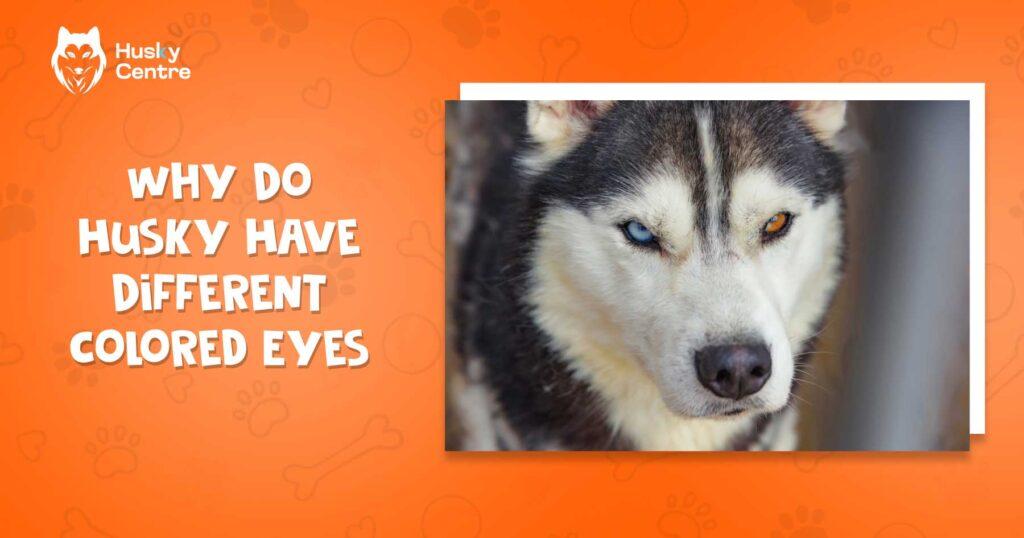Huskies have different colored eyes due to a genetic condition called heterochromia. This causes variations in eye color.
Huskies are known for their striking appearance, characterized by their thick fur and unique eye colors. The phenomenon of having two different colored eyes, known as heterochromia, is common in this breed. This genetic trait can result in one blue eye and one brown eye, or other color combinations.
Heterochromia does not affect the dog’s vision or health. It simply adds to the breed’s distinctive look. Understanding this trait can help appreciate the genetic diversity in Huskies. Many pet owners find these unique eye colors intriguing and beautiful, making Huskies a popular choice for those seeking a visually striking dog.
Heterochromia In Huskies
Huskies are known for their striking appearance, and one of their most intriguing features is their eye color. Some huskies have eyes of different colors, a condition known as heterochromia. This unique trait makes them even more captivating. Heterochromia in huskies is not just a random occurrence but has specific explanations rooted in genetics.
Explanation Of Heterochromia
Heterochromia refers to a difference in coloration, typically of the iris, but it can also occur in skin or hair. In dogs, particularly huskies, this manifests as having two different colored eyes.
There are two main types of heterochromia in dogs:
- Complete Heterochromia: One eye is a completely different color from the other.
- Partial Heterochromia: A single eye has two different colors.
Husky eye colors can vary significantly. Some common combinations include:
- One blue eye and one brown eye
- One green eye and one blue eye
- One brown eye and one amber eye
Heterochromia is harmless and does not affect the dog’s vision. It’s simply a visual quirk that adds to the breed’s charm. This trait can be found in other breeds too, but it is particularly prevalent in huskies.
Genetic Basis For This Trait In Huskies
The genetic basis for this trait in huskies lies in the complex interaction of genes that determine dog eye color genetics. The primary gene responsible for blue eyes in huskies is the ALX4 gene on chromosome 18.
Here’s a simplified table of how these genes work:
| Gene | Effect |
| ALX4 | Causes blue eyes |
| MC1R | Influences brown pigmentation |
| TYRP1 | Affects black and brown coloration |
Reasons for husky eye color differences are primarily genetic. If a husky inherits the ALX4 gene from one parent, it may have one blue eye. If it inherits this gene from both parents, it might have two blue eyes.
Heterochromia in huskies can also result from genetic mutations. These mutations can occur naturally and are passed down through generations. They cause the pigment-producing cells (melanocytes) in each eye to develop differently.
Understanding these genetic factors helps explain why some huskies have such unique and mesmerizing eyes.
Is Heterochromia A Health Concern For Huskies?
Huskies are known for their striking appearance, and one of their most unique features is their different colored eyes, a condition known as heterochromia. Many owners wonder, “Is heterochromia a health concern for huskies?” Understanding the implications of this fascinating trait can help ensure your husky remains healthy and happy.
Eye Conditions To Monitor
Heterochromia in huskies is usually not a health concern. This genetic condition affects the pigmentation of the iris, leading to one eye being a different color from the other. While heterochromia itself is harmless, it’s important to monitor your husky’s eye health to prevent other potential issues.
Here are some eye conditions to watch for:
- Cataracts: Cloudy lenses can impair vision. Look for signs of your dog bumping into objects or having trouble seeing.
- Glaucoma: Increased pressure within the eye can cause pain and vision loss. Symptoms include redness, tearing, and a cloudy cornea.
- Progressive Retinal Atrophy (PRA): This genetic condition leads to gradual vision loss. Night blindness is an early sign.
- Corneal Dystrophy: Fat deposits in the cornea can affect vision. This condition often appears as white or gray spots.
Regular veterinary check-ups are crucial for maintaining eye health in huskies. A veterinarian can diagnose and treat these conditions early, ensuring your dog’s vision remains intact. Here is a table summarizing these conditions:
| Condition | Symptoms | Treatment |
| Cataracts | Cloudy eyes, vision impairment | Surgery |
| Glaucoma | Redness, tearing, cloudy cornea | Medication, surgery |
| PRA | Night blindness, gradual vision loss | No cure, manage symptoms |
| Corneal Dystrophy | White or gray corneal spots | Monitor, no treatment needed |
While heterochromia and dog health are usually not related, monitoring your husky’s eyes for these conditions is crucial. Regular check-ups and awareness of symptoms will help you address any husky health concerns promptly.
Benefits And Drawbacks Of Heterochromia
Have you ever wondered why Huskies have different colored eyes? This striking feature, known as heterochromia, makes them stand out in a crowd. Heterochromia occurs due to variations in the pigment of each eye. While it’s visually stunning, it comes with both benefits and drawbacks. Let’s explore the unique traits in Huskies that make their eyes so captivating and what it means for their health.
How Heterochromia Make Visually Unique
Heterochromia gives Huskies a visually unique look that captures attention. This trait means one eye may be blue, while the other could be brown or amber. This variation in eye color is due to differences in melanin levels.
Advantages of Heterochromia:
- Aesthetic Appeal: Many people find Huskies with different colored eyes irresistible.
- Breed Recognition: Heterochromia makes it easy to identify a Husky, adding to their charm.
- Social Media Popularity: These dogs often become social media stars because of their striking appearance.
In a study of dog breeds, Huskies consistently rank high in popularity due to their unique eye colors. Their distinct appearance also plays a role in their behavior and interaction with humans.
Table: Common Eye Color Combinations in HuskiesLeft EyeRight EyeBlueBrownAmberBlueBrownAmber
With their enchanting eyes, Huskies often become the center of attention. Their heterochromia not only enhances their looks but also adds to their uniqueness.
Mistake It For A Health Issue
Some people mistake heterochromia for a health issue, but it’s usually harmless. This condition doesn’t affect the dog’s vision or health. Still, it’s essential to know the pros and cons of heterochromia to ensure your Husky stays healthy.
Common Misconceptions:
- Vision Problems: Many think different colored eyes cause vision issues, but that’s false.
- Genetic Disorders: People often link heterochromia to genetic disorders, which is rare in Huskies.
- Health Risks: Some believe it indicates underlying health problems, which is mostly untrue.
In rare cases, if your Husky’s eye color changes suddenly, it could signal an issue. Always consult a vet if you notice any unexpected changes. Knowing the difference between natural heterochromia and potential health concerns ensures your Husky stays in top condition.
Table: Pros and Cons of HeterochromiaProsConsUnique AppearancePotential MisdiagnosisBreed RecognitionUnnecessary Health ChecksSocial Media FamePublic Misconceptions
Understanding heterochromia’s advantages and disadvantages helps you appreciate your Husky’s unique traits without undue worry.
Frequently Asked Questions
Why Do Huskies Have Different Colored Eyes?
Huskies have different colored eyes due to a genetic mutation. This condition is called heterochromia. It is harmless and common in this breed.
Is Heterochromia In Huskies Rare?
No, heterochromia is not rare in Huskies. It is a common trait. Many Huskies have one blue and one brown eye.
Are Huskies With Different Colored Eyes Healthy?
Yes, Huskies with different colored eyes are healthy. The eye color difference does not affect their vision or health.
Does Heterochromia Affect A Husky’s Vision?
No, heterochromia does not affect a Husky’s vision. They see just as well as Huskies with matching eye colors.
Conclusion
Huskies’ different colored eyes, also known as heterochromia, add to their unique charm. This trait is both genetic and harmless. Understanding this fascinating feature helps us appreciate these beautiful dogs even more. Embrace your Husky’s unique look, knowing it’s a natural part of their genetic makeup.


Meet Jarred, the heart and soul behind HukyCentre. With a deep affection for furry friends, he pours his passion into every word he writes. His genuine love for dogs shines through in his engaging and informative content. As a dedicated dog enthusiast, Jarred’s goal is to share valuable insights and tips that resonate with fellow dog lovers. Join Jarred on the journey as he celebrates the joy and companionship that dogs bring into our lives.



